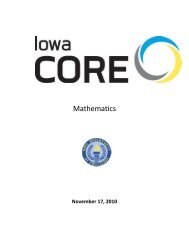The Arc's Self-Determination Scale: Procedural Guidelines
The Arc's Self-Determination Scale: Procedural Guidelines
The Arc's Self-Determination Scale: Procedural Guidelines
Create successful ePaper yourself
Turn your PDF publications into a flip-book with our unique Google optimized e-Paper software.
3. Goals should reflect something that the student wants to<br />
improve on.<br />
4. Goals should have specific, practical starting and finishing<br />
dates.<br />
5. Goals should be written.<br />
6. Goals should be stated in terms of anticipated outcomes.<br />
7. Students should be able to visually track their progress on<br />
the goal.<br />
<strong>The</strong> educational planning and decision-making process is an<br />
enterprise that revolves around goal-setting, implementation and<br />
evaluation. <strong>The</strong> involvement of students in this process, from<br />
elementary school through graduation, provides the best<br />
educational environment to promote effective goal setting and<br />
attainment skills. Teachers and parents can model effective skills<br />
like identifying short and long-term goals, describing objectives,<br />
implementing plans based on these goals and objectives and<br />
reevaluating and refining these plans.<br />
<strong>Self</strong>-Observation, <strong>Self</strong>-Evaluation and <strong>Self</strong>-Reinforcement Skills<br />
<strong>The</strong> definitional framework of self-determined behavior identified<br />
such action as self-regulated, and self-regulated behavior as<br />
constituting, at the very least, the essential skills of selfobservation,<br />
self-evaluation and self-reinforcement. Whitman<br />
(1990) defined self-regulation as "a complex response system that<br />
enables individuals to examine their environments and their<br />
repertoires of responses for coping with those environments to<br />
make decisions about how to act, to act, to evaluate the desirability<br />
of the outcomes of the action, and to revise their plans as<br />
necessary." It is within this broader context that self-regulation<br />
skills are important for self-determined behaviors. Whitman goes<br />
on to maintain that, in order to show dynamic self-regulation,<br />
individuals must make decisions concerning what skills to use in<br />
which situation, examine the task at hand and their strategic<br />
repertoire, and formulate, enact and evaluate a plan of action, with<br />
revisions if necessary. <strong>Self</strong>-regulation differs from automatic<br />
processing in that it requires focused attention and continuous<br />
decision-making among alternative responses (Whitman, 1990).<br />
<strong>Self</strong>-regulation includes the skills of self-monitoring (observation<br />
of one's social and physical environment), self-evaluation (making<br />
judgments about the acceptability of this behavior through<br />
comparing information about what one is doing with what one<br />
ought to be doing) and, based upon the outcome of this selfevaluation,<br />
self-reinforcement.<br />
Internal Locus of Control<br />
34
















